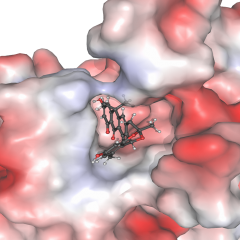Mobli Group
Bioactive peptides as natural modulators of cellular receptors of importance in agriculture and medicine
Bioactive peptides have long been recognised as important messengers in cellular communication and are integral to our understanding of basic physiological processes. Their potential as natural substrates for biological receptors has been leveraged successfully in some of the most important therapeutics of our time, such as insulin and oxytocin. In recent years, increased attention has been given to this molecular class due to the ease of generating large libraries of these peptides under selection pressure. This can yield potent drug leads through mRNA and phage display technologies. The potency and selectivity of these molecules come from their well-defined three-dimensional structures, which are often constrained by side-chain and/or backbone linkages that stabilise their 3D shape. Our group has contributed significantly to the understanding of the structure, dynamics, and function of constrained peptides.
Our basic understanding of the physicochemical properties of bioactive peptides comes from studies of their structural and chemical properties. The Mobli group uses cutting edge biophysical methods to study the structure and function of constrained peptides. Our detailed studies of the peptide structure, dynamics and and function have offered novel insights ranging from the basic chemistry of peptide side chains to the structural basis of peptide-receptor interactions and the evolution of neofunctionalisation of stable structural scaffolds.
Research Areas
- Biochemistry
- Biophysics
- Chemical biology
- Computational biology
- Spectroscopy (nuclear magnetic resonance)
- Signal processing
Research Approach
A key aspect of our approach is to be inspired by nature. Using the natural diversity of signalling molecules, from hormones to venom peptides, we explore how changes through evolution lead to changes in function. This approach allows us to uncover new knowledge in biology that can be directly applied to solving problems in health and agriculture.
Research Highlights
PhD opportunities
Funding
Since 2019
- Defining a new family of sodium channel accessory proteins
(2024–2027) ARC Discovery Projects - A national network for magnetic resonance spectroscopy
(2024–2025) ARC Linkage Infrastructure, Equipment and Facilities - High-Resolution Electron Paramagnetic Resonance Imaging and Spectroscopy
(2023–2024) ARC Linkage Infrastructure, Equipment and Facilities - Autocyclases: A new class of self-cyclising proteins
(2022–2025) ARC Discovery Projects - Bivalent analgesics: rational design of selective ion channel inhibitors with optimised mechanism of action
(2021–2023) NHMRC IDEAS Grants - A new source of bivalent molecules from nature
(2019–2022) ARC Discovery Projects - Accessing structurally elusive states of sodium channels as novel analgesic targets
(2019–2022) NHMRC Project Grant - Molecular basis and inhibition of TIR-domain function in Toll-like receptor and neuronal cell-death pathways
(2019–2021) NHMRC Project Grant
Publications
Click here to view Mobli group publications











